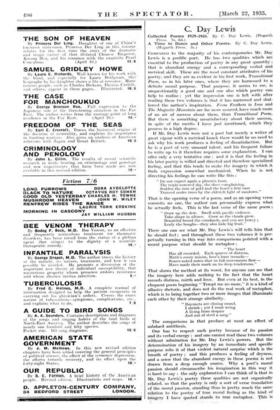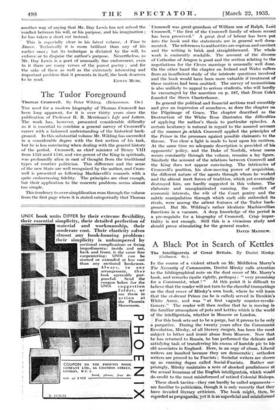C. Day Lewis
A Time to Dance and Other Poems. By C. Day Lewis. (Hogarth Press.. 5s.) COMPARED to the majority of his contemporaries Mr. Day Lewis is a prolific poet. He has two qualities which are essential to the production of poetry in any great quantity= : that is abundant energy and a corresponding verbal and metrical skill. These are the most constant attributes of his poetry, and they are as evident in his first work, Transitional Poem, as in his later ones, where they are harnessed to a definite moral purpose. That purpose, it seems to me, is unquestionably a good one and one also which poetry can help to realize ; yet the impression one is left with after reading these two volumes is that it has narrowed and shal- lowed the author's inspiration. From Feathers to Iron and The Magnetic Mountain are far more assured, have much more of an air of success about them, than Transitional Poem. But there is something unsatisfactory about their success,
in spite of the merits I have just mentioned, which they possess in a high degree.
- If Mr. Day Lewis were not a poet but merely a writer of great vigour with a metrical knack there would be no need to ask why his work produces a feeling of dissatisfaction. But he is a poet of very unusual talent, and his frequent failure to write up to it therefore requires some explanation. I can offer only a very tentative one ; and it is that the feeling in his later poetry is willed and directed and therefore specialized feeling, and that this tends to make the imagery in which it finds expression somewhat mechanical. When he is not directing his feelings he can write like this :
• " Do not expect again a phoenix hour,
The triple-towered sky, the dove complaining, Sudden the rain of gold and the heart's first ease Tranced under trees by the eldritch light of sundown."
That is the opening verse of a poem, and as an opening verse commits no one, the authoi can presumably express what he actually feels. This is the last verse of the same poem :
" Draw up the dew. 'Swell with pacific violence. Take shape in silence. Grow as the clouds grew. Beautiful brood the cornlands, and you are heavy ; Leafy the boughs—they also hide big fruit."
There one can see what Mr. Day Lewis's will tells him that he should feel ; and throughout these two volumes it is per- petually turning in this way into comparisons pointed with a moral purpose what should be metaphor :
" The heart Has all recorded. Each quaver of distress, Mirth's every minim, love's least tremolo- Scarce-noted notes that to full movements flow— Have made their mark on its deep tenderness."
That shows the method at its worst, for anyone can see that the imagery here adds nothing to the fact that the heart records distress, mirth and love. But even at its best, in the eloquent poem beginning " Tempt me no more," it is a kind of allusive rhetoric, and does not do the real work of metaphor, which is to bring together two or more images that illuminate each other by their strange similarity.
" Bayonets are closing round. I shrink ; yet I must wring A living from despair And out of steel a song."
. The comparisons in that produce at most an effect of subdued antithesis.
One has to respect such poetry because of its passion
and its verbal energy ; and one cannot read these two volumes without admiration for Mr. Day Lewis's powers. But the determination of his imagery by an. immediate and specific purpose robs it of that violent natural surprise which is the breath of poetry ; and this produces a feeling of dryness, and a sense that the abundant energy in these poems is not drawn from a deep enough source. Why a poet's moral passion should circumscribe his imagination in this way it is hard to say : the only explanation I can think of is that in Mr. Day Lewis's poetry these qualities are not organically related, so that the poetry is only a sort of verse translation of the moral passion, standing -thus in pretty much the same relation to the poetry of true moral feeling as the kind: of imagery I have quoted stands to true metaphor. This is
another way of saying that Mr. Day Lewis has not solved the "conflict between his will, or his purpose, and his imagination ; he has taken a short cut instead.
This is especially clear in his latest volume, A Time ''to Dance. Technically it is more brilliant than any of his earlier ones ; but its technique is dictated by the will, to enforce or to disguise the author's purpose. Nevertheless, as 'Mr. Day Lewis is a poet of unusually fine endowment, even in it there are many verses of the purest poetry ; and Mr the sake of these as well as the extremely interesting and important problem that it presents in itself, the book deserves





























































 Previous page
Previous page